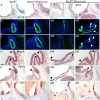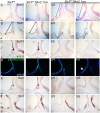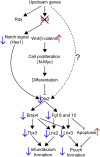Heterozygous variants in SIX3 and POU1F1 cause pituitary hormone deficiency in mouse and man
- PMID: 35951005
- PMCID: PMC9851746
- DOI: 10.1093/hmg/ddac192
Heterozygous variants in SIX3 and POU1F1 cause pituitary hormone deficiency in mouse and man
Abstract
Congenital hypopituitarism is a genetically heterogeneous condition that is part of a spectrum disorder that can include holoprosencephaly. Heterozygous mutations in SIX3 cause variable holoprosencephaly in humans and mice. We identified two children with neonatal hypopituitarism and thin pituitary stalk who were doubly heterozygous for rare, likely deleterious variants in the transcription factors SIX3 and POU1F1. We used genetically engineered mice to understand the disease pathophysiology. Pou1f1 loss-of-function heterozygotes are unaffected; Six3 heterozygotes have pituitary gland dysmorphology and incompletely ossified palate; and the Six3+/-; Pou1f1+/dw double heterozygote mice have a pronounced phenotype, including pituitary growth through the palate. The interaction of Pou1f1 and Six3 in mice supports the possibility of digenic pituitary disease in children. Disruption of Six3 expression in the oral ectoderm completely ablated anterior pituitary development, and deletion of Six3 in the neural ectoderm blocked the development of the pituitary stalk and both anterior and posterior pituitary lobes. Six3 is required in both oral and neural ectodermal tissues for the activation of signaling pathways and transcription factors necessary for pituitary cell fate. These studies clarify the mechanism of SIX3 action in pituitary development and provide support for a digenic basis for hypopituitarism.
© The Author(s) 2022. Published by Oxford University Press.
Figures









Similar articles
-
[Genetic background of inherited multiple pituitary hormone deficiency. Mutations of PROP1 gene in Hungary].Orv Hetil. 2011 Feb 6;152(6):221-32. doi: 10.1556/OH.2011.29032. Orv Hetil. 2011. PMID: 21278027 Hungarian.
-
A novel heterozygous intronic mutation in POU1F1 is associated with combined pituitary hormone deficiency.Endocr J. 2017 Feb 27;64(2):229-234. doi: 10.1507/endocrj.EJ16-0361. Epub 2016 Nov 22. Endocr J. 2017. PMID: 27885216
-
Two novel mutations in the POU1F1 gene generate null alleles through different mechanisms leading to combined pituitary hormone deficiency.Clin Endocrinol (Oxf). 2012 Mar;76(3):387-93. doi: 10.1111/j.1365-2265.2011.04236.x. Clin Endocrinol (Oxf). 2012. PMID: 22010633
-
Growth hormone deficiency and combined pituitary hormone deficiency: does the genotype matter?Clin Endocrinol (Oxf). 2005 Aug;63(2):121-30. doi: 10.1111/j.1365-2265.2005.02289.x. Clin Endocrinol (Oxf). 2005. PMID: 16060904 Review.
-
POU1F1 mutations in combined pituitary hormone deficiency: differing spectrum of mutations in a Western-Indian cohort and systematic analysis of world literature.Pituitary. 2021 Oct;24(5):657-669. doi: 10.1007/s11102-021-01140-9. Epub 2021 Mar 20. Pituitary. 2021. PMID: 33742319
Cited by
-
Hypopituitarism: genetic, developmental, and acquired etiologies with a focus on the emerging concept of autoimmune hypophysitis.Endocr J. 2025 Jun 2;72(6):649-662. doi: 10.1507/endocrj.EJ25-0035. Epub 2025 Mar 27. Endocr J. 2025. PMID: 40139845 Free PMC article. Review.
-
Nucleoredoxin regulates WNT signaling during pituitary stem cell differentiation.bioRxiv [Preprint]. 2025 Feb 3:2025.01.30.635771. doi: 10.1101/2025.01.30.635771. bioRxiv. 2025. Update in: Hum Mol Genet. 2025 May 6;34(10):870-881. doi: 10.1093/hmg/ddaf032. PMID: 39975280 Free PMC article. Updated. Preprint.
-
Re-analysis of gene mutations found in pituitary stalk interruption syndrome and a new hypothesis on the etiology.Front Endocrinol (Lausanne). 2024 Feb 23;15:1338781. doi: 10.3389/fendo.2024.1338781. eCollection 2024. Front Endocrinol (Lausanne). 2024. PMID: 38464967 Free PMC article.
-
Impact of Sonic Hedgehog-dependent sphenoid bone defect on craniofacial growth.Clin Exp Dent Res. 2024 Apr;10(2):e861. doi: 10.1002/cre2.861. Clin Exp Dent Res. 2024. PMID: 38558491 Free PMC article.
-
Nucleoredoxin regulates WNT signaling during pituitary stem cell differentiation.Hum Mol Genet. 2025 May 6;34(10):870-881. doi: 10.1093/hmg/ddaf032. Hum Mol Genet. 2025. PMID: 40044116 Free PMC article.
References
-
- Budny, B., Zemojtel, T., Kaluzna, M., Gut, P., Niedziela, M., Obara-Moszynska, M., Rabska-Pietrzak, B., Karmelita-Katulska, K., Stajgis, M., Ambroziak, U. et al. (2020) SEMA3A and IGSF10 are novel contributors to combined pituitary hormone deficiency (CPHD). Front Endocrinol (Lausanne), 11, 368. - PMC - PubMed
-
- Jee, Y.H., Gangat, M., Yeliosof, O., Temnycky, A.G., Vanapruks, S., Whalen, P., Gourgari, E., Bleach, C., Yu, C.H., Marshall, I. et al. (2021) Evidence that the etiology of congenital hypopituitarism has a major genetic component but is infrequently monogenic. Front. Genet., 12, 697549. - PMC - PubMed
-
- Calloni, S.F., Cohen, J.S., Meoded, A., Juusola, J., Triulzi, F.M., Huisman, T., Poretti, A. and Fatemi, A. (2017) Compound heterozygous variants in ROBO1 cause a neurodevelopmental disorder with absence of transverse pontine fibers and thinning of the anterior commissure and corpus callosum. Pediatr. Neurol., 70, 70–74. - PubMed
Publication types
MeSH terms
Substances
Grants and funding
LinkOut - more resources
Full Text Sources
Molecular Biology Databases

